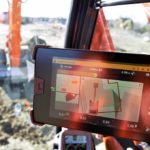Operator training can save on costs, increase productivity and maximise site safety, all for less than one per cent of the cost of the equipment. So, how do you find out what training is available so that you can choose the right course? Here Ian Barnes, Head of Business at SITECH UK & Ireland, explains how site managers can get the most from their equipment by training their workforce.
To get the maximum return on investment, it is important for construction companies to select the right equipment for the job and for machine operators to understand how to use it in the most efficient way. If operators have the necessary training behind them, they will be able to understand the equipment’s benefits and limitations, work safely and achieve the desired results more quickly and with minimal errors.
Investing in the correct initial training allows site managers to lay a solid foundation of knowledge across the entire workforce. Operators can look to industry experts for training support to gradually build employee’s skills and help unlock the full operating potential of the machinery. As well as better use of equipment, training can help employees pick up new digital and software skills.
Choosing your training
Understanding the needs of operators and their roles can help site managers plan employee training sessions. For example, if the site manager becomes aware that the team is not using an excavator’s in-built technology to its full potential, they can bring experts into the company to train the staff the specific issue, whether this is to engage automatic functions, or how to calibrate the machine for different types of material.
Training provides operators with more experience using guidance software, such as Trimble® Earthworks, to control the excavator boom, stick and bucket in a smooth and efficient motion. Therefore, they can apply this knowledge to accurately achieve a consistent grade in much less time than beforehand, increasing productivity and boosting the business’s return on investment.
The future of training
Looking ahead, it is important that essential workers get hands-on training safely, so they can get to grips with any new equipment they are required to use. As restrictions lift, we will see training group sizes slowly increase, but we also predict a longer-term shift in how businesses want training delivered.
Some construction businesses prefer the convenience of instructors going to their sites or offices to train their employees, rather than sending them to dedicated centres. However, many businesses enjoy the enhanced experience of attending a training facility, such as SITECH’s new venue in Norton Canes. Centres like this offer different training systems, such as the Tenstar simulation, which allows operators to see and feel how the excavation equipment works in a classroom environment before they set foot in an expensive piece of equipment.
The best training approach depends on the technology, application and team. However, in future, training companies may have to be more flexible in their offering to meet the preferences of individual customers.
As more companies begin to use advanced technologies, such as augmented reality (AR) cameras and automated mapping, we can also expect to see a host of new training techniques emerge. Being fully trained to use digital technology can give operators a better understanding of the work in-hand, while enabling them to benefit from improved communication between the site and office.
Ensuring that operators are fully trained and can use their construction technology and equipment to its full potential will enable site managers to boost project productivity and get the most out of their equipment.









